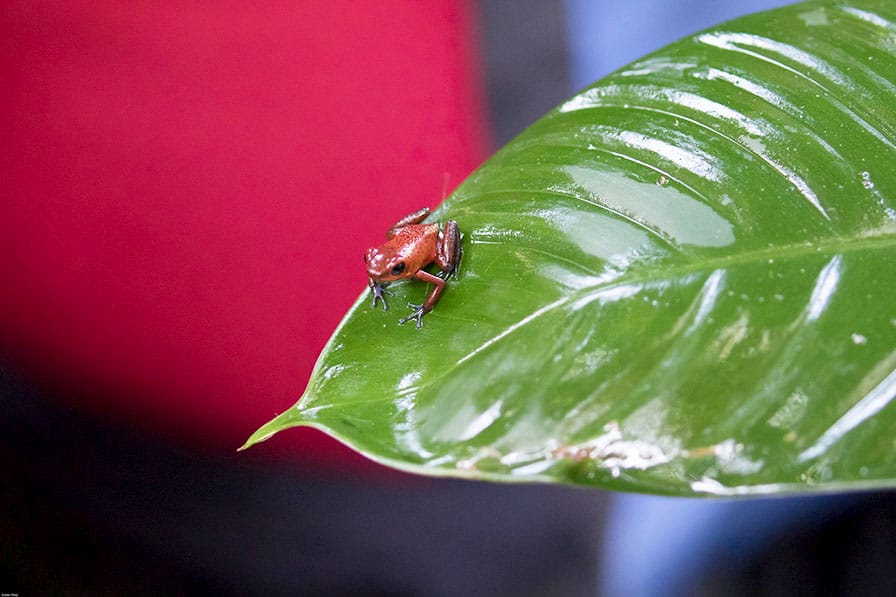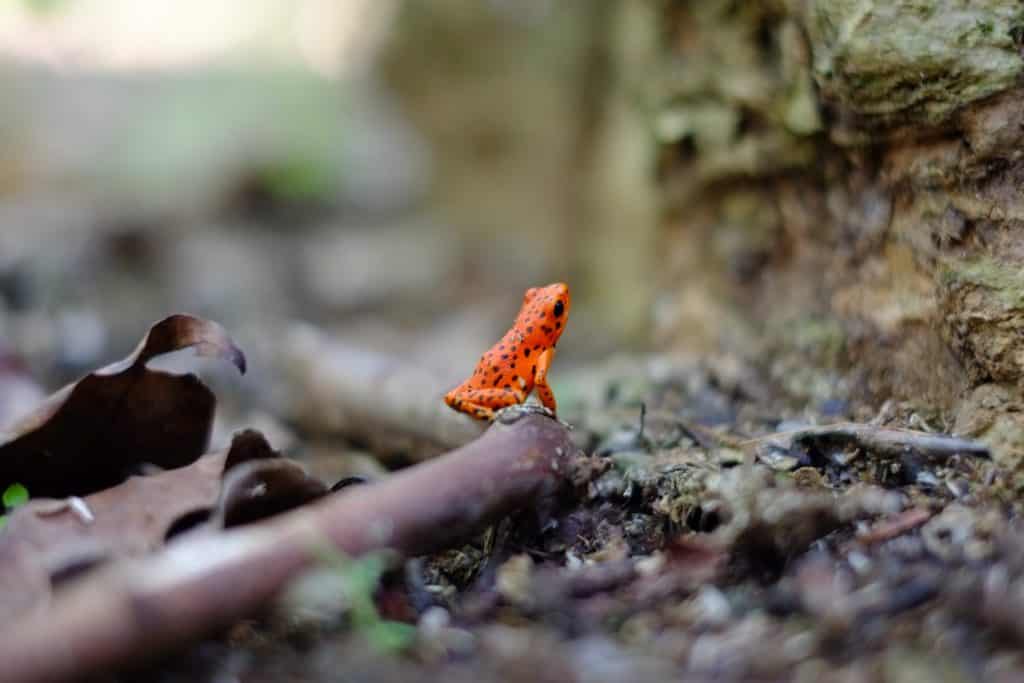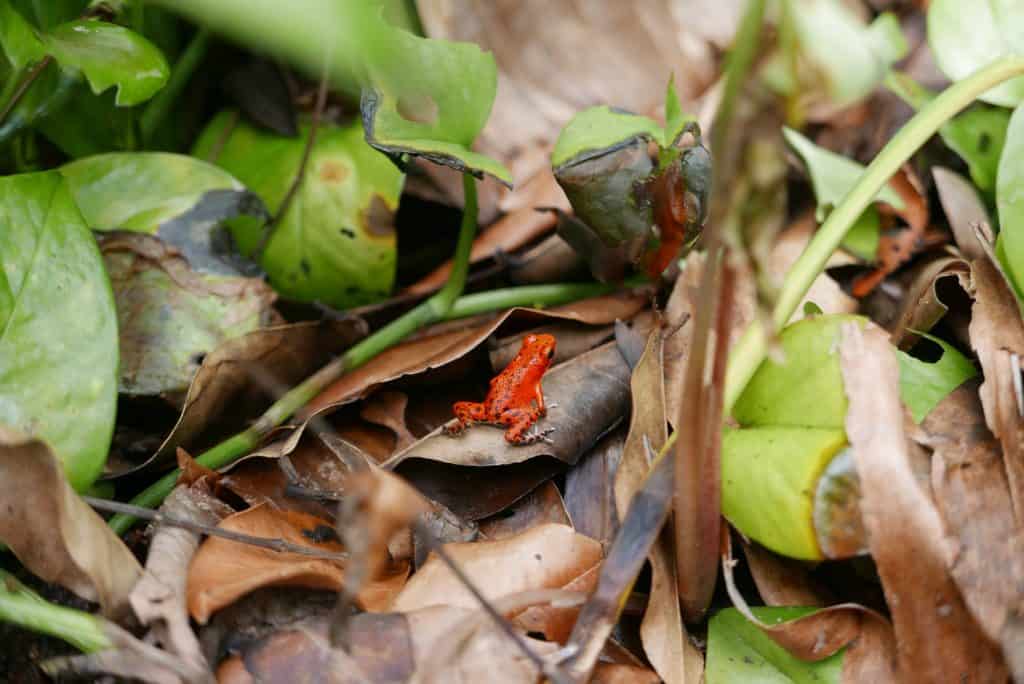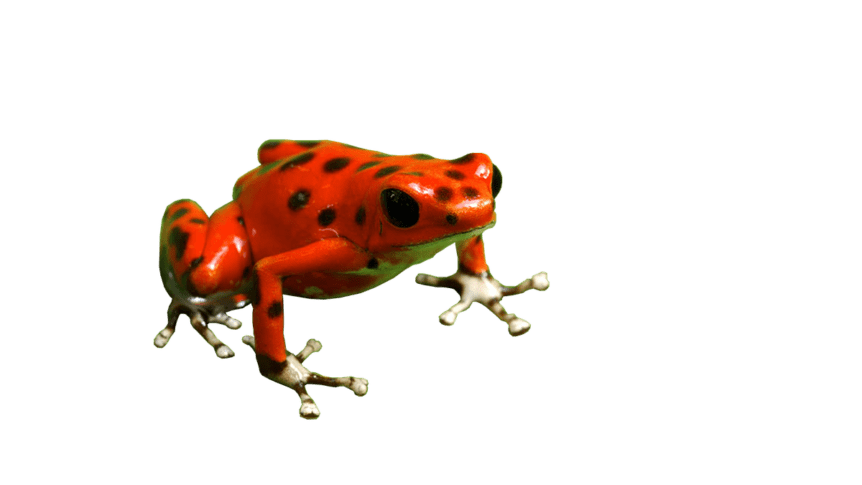
While hiking through Costa Rica’s rainforests, you might spot a small frog with bright red skin and black polka dots: the strawberry poison dart frog. Its bold appearance and tiny size make it stand out, but there’s more to this creature than its looks. In this guide, we’ll cover everything you need to know about the strawberry poison dart frog, from its toxic skin to where you can find it in Costa Rica.
What Is a Strawberry Poison Dart Frog?
The strawberry poison dart frog, known scientifically as Oophaga pumilio, is a member of the poison dart frog family. Its red skin, often marked with black spots, signals its toxicity to predators. These frogs live in Costa Rica’s lowland forests and can also be seen in private reserves or zoos worldwide.
Their small size and striking colors have made them a favorite among wildlife enthusiasts, but their toxic nature adds a layer of intrigue. Studying these frogs helps scientists understand how animals adapt to their environments through chemical defenses.
Appearance: A Range of Colors
The typical strawberry poison dart frog has a red body with black spots, but its look varies. One common variant, the “blue jeans morph,” pairs a red body with blue or purple legs. Other frogs in this species may show yellow, green, orange, white, or black hues. Measuring 0.75 to 1.5 inches, their small bodies have four un-webbed toes on each foot, suited for moving through the forest.
These color variations, or morphs, often depend on their specific location, with Costa Rican populations showing some of the most diverse patterns. Observing these differences in the wild can feel like uncovering a hidden palette of nature’s creativity.
Where to See Them in Costa Rica
Costa Rica’s warm, humid forests provide the perfect home for strawberry poison dart frogs, and several regions offer prime viewing opportunities. Knowing where to look can turn a casual hike into a memorable wildlife encounter. These frogs are found in lowland forests, particularly in:
- Puerto Viejo de Talamanca: A key spot on the Caribbean coast for wildlife viewing.
- Puerto Viejo de Sarapiquí: A forested area where these frogs are often seen.
- Tortuguero National Park: A biodiversity-rich park where guides can help locate them.
For the best chance to spot them, join a guided tour, as their small size and camouflage make them hard to find without assistance. Many tour operators in these areas offer early morning or late afternoon excursions, when the frogs are most active, increasing your odds of a sighting.
Quick Facts About the Strawberry Poison Dart Frog
If you’re planning a trip to see these frogs, a few key facts can deepen your appreciation for them. The table below summarizes their traits, from size to diet, offering a quick reference for travelers and curious readers.
| Characteristic | Details |
|---|---|
| Scientific Name | Oophaga pumilio |
| Size | 0.75–1.5 inches, weighing about 1 oz |
| Lifespan | Up to 15 years in captivity; shorter in the wild |
| Diet | Insect eggs, ants, mites, flies, beetles, millipedes |
| Range | Central America (Costa Rica, Panama, Nicaragua) |
| Conservation Status | Least Concern, but affected by habitat loss |
| Predators | Mainly the fire-bellied snake (Leimadophis epinephelus) |
These facts highlight why the strawberry poison dart frog is a fascinating subject for both casual visitors and researchers studying amphibian ecology.
Why the Name “Poison Dart Frog”?
The “strawberry” in its name comes from its red coloring, while “poison dart frog” refers to how indigenous groups used its toxic skin secretions to tip blow darts for hunting. Though toxic to predators, the frog’s secretions are unlikely to harm humans beyond mild skin irritation if handled. It’s best to observe them without touching. This historical use of their toxins connects the frog to cultural practices in Central America, where communities relied on natural resources for survival. Today, the name sparks curiosity among travelers eager to learn about Costa Rica’s wildlife and its human history.
Daily Life: Behavior and Feeding

Unlike many frogs, which are active at night, strawberry poison dart frogs move around during the day, making them easier to spot on guided hikes. Their sharp vision helps them find small prey like ants, mites, flies, and insect eggs. They especially rely on formicine ants, which provide the chemicals for their toxic skin. In the wild, they may eat up to 14 times an hour, while in captivity, they consume 50–75 fruit flies daily.
These frogs are territorial. Males use calls and a toe-tapping motion to communicate, signaling to mates, defending their space, or showing stress. This behavior peaks during the rainy season (May–November), when breeding occurs. Their active daytime habits and frequent feeding make them a dynamic part of the forest ecosystem, constantly interacting with their surroundings.
Reproduction: A Careful Process
Strawberry poison dart frogs reproduce differently from other frogs. Females lay 2–12 eggs on leaves or near water, far fewer than the hundreds laid by other species. After hatching, the female carries each tadpole to a small water pool, often in plants like bromeliads, and feeds them unfertilized eggs until they mature.
This hands-on parenting is unusual for frogs and adds to their uniqueness. The breeding season, tied to Costa Rica’s rainy months, ensures water sources are available for tadpole development. This careful reproductive strategy reflects the frog’s adaptation to its environment, where resources can be scarce, and survival depends on precision.
Are They a Threat?
Their toxic skin deters most predators, with the fire-bellied snake (Leimadophis epinephelus) being their only known natural enemy, resistant to the toxins. For humans, the frogs aren’t dangerous but can cause irritation if touched.
The greater threat to them is habitat loss from deforestation and climate shifts. This balance of being both predator-proof and vulnerable highlights their complex role in the ecosystem. Travelers should appreciate their resilience while recognizing the importance of preserving their forest homes.
Conservation: Stable but at Risk
The strawberry poison dart frog is listed as “Least Concern” by the IUCN due to its stable population. However, deforestation and habitat changes in Costa Rica pose challenges. Protected areas like Tortuguero National Park and private reserves help safeguard their future.
Conservation efforts also involve local communities and ecotourism, which raise awareness and funds for habitat preservation. By visiting responsibly, travelers can support these initiatives and ensure future generations can enjoy these frogs in the wild.
Other Poison Dart Frogs in Costa Rica
Costa Rica hosts seven poison dart frog species, each with distinct colors:
- Golden Poison Dart Frog
- Yellow-Banded Poison Dart Frog
- Strawberry Poison Dart Frog
- Blue Poison Dart Frog
- Green Poison Dart Frog
- Black Poison Dart Frog
- Copper Poison Dart Frog
These species highlight Costa Rica’s diverse wildlife, a draw for nature enthusiasts. Each type occupies slightly different niches, from forest floors to tree canopies, contributing to the country’s reputation as a biodiversity hotspot. Exploring these frogs in their natural settings offers a glimpse into the complexity of Costa Rican ecosystems.
How to Spot Them in Costa Rica

Costa Rica’s rainforests are teeming with wildlife, and spotting a strawberry poison dart frog is a rewarding experience for patient travelers. To see them in the wild, try these tips:
- Join a Guided Tour: Local experts can locate frogs that blend into their surroundings.
- Visit in the Rainy Season: Frogs are more active from May to November.
- Wear Proper Clothing: Long sleeves, sturdy shoes, and insect repellent are needed for forest hikes.
- Respect Nature: Don’t touch frogs or disturb their environment.
Eco-lodges or reserves with night tours can also offer good viewing opportunities, as some frogs are active at dusk. Booking with reputable operators ensures you’re supporting sustainable tourism that prioritizes wildlife protection.
Why These Frogs Matter
Strawberry poison dart frogs play a role in Costa Rica’s ecosystems by eating small insects, helping maintain balance in the forest. Their sensitivity to environmental changes also makes them indicators of forest health. Protecting their habitats supports the broader biodiversity that defines Costa Rica. These frogs remind us of the delicate connections within ecosystems, where even the smallest creatures have a significant impact. By learning about and respecting them, visitors contribute to preserving Costa Rica’s natural heritage.
Next time you’re in Puerto Viejo or Tortuguero, watch for a red frog hopping through the forest. The strawberry poison dart frog is a small but fascinating part of Costa Rica’s wildlife. Have you seen one? Share your experience in the comments, and let’s keep exploring Costa Rica’s natural wonders!

